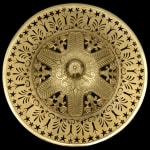Literature
G. Haase-Messner and G. Reinheckel, "Kunsthandwerk des 18. und 19. Jahrhunderts, Schloss Pillnitz, Dresden", 1978, p. 157, pl. E.26, illustrating a very similar model housed at Schloss Pillnitz Dresden. Hans Ottomeyer and Peter Pröschel, "Vergoldete Bronzen", 1986, p. 362, pl. 5.12.1, illustrating a perfume burner of almost identical form, size and individual design but without the domed cover in the Badisches Landesmuseum, Karlsruhe.
A very fine Empire gilt bronze brûle-parfum, the domed cover chased and pierced with scrolls, acanthus and lotus leaves, an anthemion band and stars surmounted by a fluted vase-shaped finial over a dished bowl with gadrooned rim, on a spreading triangular shaft with canted corners headed by a Corinthian capital and mounted on each side with a star above a classical female in diaphanous drapery holding a flaming torch in either hand over a tiered and scrolled pedestal flanked by seated winged sphinxes, the shaft supported by ball feet on a cast pedestal supported at each corner by a classical winged female monopodia with lion paw foot on a concave-sided tripartite base with canted corners and a band of alternating lotus leaves and flower heads, on a square black marble base
Paris, date circa 1805
Height 60 cm.
This imposing brûle-parfum combines three leading stylistic elements that made up the Empire style. The first is the enduring preoccupation with ancient Greek and Roman art as evidenced by the classical torch-bearing females as well as the acanthus and anthemion bands. Secondly it reflects the ‘goût Egypte’ in the form of sphinxes, female monopodia supports and lotus leaves and finally the ‘goût Turc’ as expressed by the stars. Given the brûle-parfum’s overall style and individual decoration, it was either inspired or even made after a design by Charles Percier (1764-1838), who with Pierre François Léonard Fontaine (1762-1853) was instrumental in creating for Napoleon the Empire style. They often included classical beauties, sphinxes and monopodia supports within their designs for brûle-parfums, candelabra, plinths and other decorative objects, which were largely promoted through the publication of their ‘Recueil des Décorations Intérieures’, 1801.



